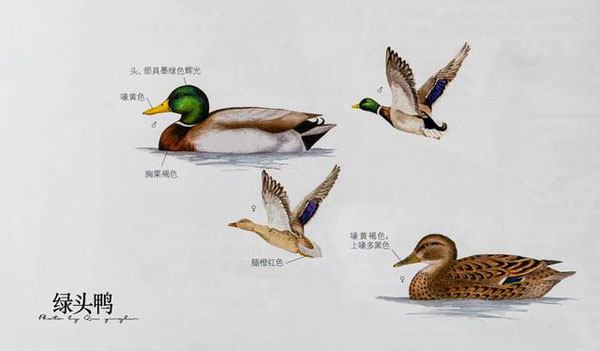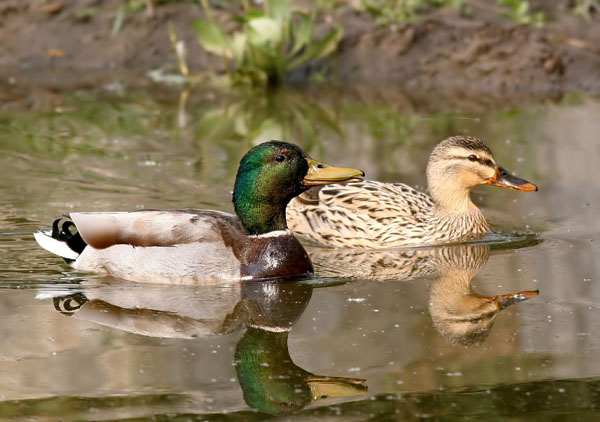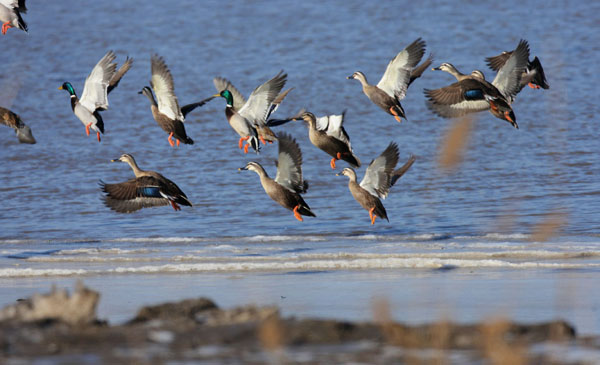Anas platyrhynchos
IUCN
LCBasic Information
Scientific classification
- name:Anas platyrhynchos
- Scientific Name:Big green head, big red leg duck, official duck, on duck, hemp duck, green side,Anas platyrhynchos,Mallard,Common Mallard
- Outline:Waterfowl
- Family:Anseriformes Anseriidae
Vital signs
- length:47-62cm
- Weight:About 1 kilogram
- lifetime:6-8years
Feature
Male bird head, neck green, with bright metallic luster; Female black from head to occipital, with brownish yellow feather margin.
Distribution and Habitat
The Chinese breed in the northwest, northeast, North and western plateaus, and overwinter in coastal areas, the Yellow River and its southern basin, including Taiwan Island and Hainan Island. It breeds in temperate areas of the northern border, winters in the southern part of the distribution, and is a resident bird in some temperate and subtropical areas.
Mallard ducks mainly live in lakes, rivers, ponds, swamps and other waters rich in aquatic plants. It also occurs in open lakes, reservoirs, rivers, sandbanks, and coastal marshes and grasslands during winter and migration.
Appearance
The head and neck of the male bird are dark green and metallic, with a white collar and chestnut red chest, the rest of the body is gray, the wing mirror blue-purple, and the tail is black. The female is yellow-brown with mottled brown stripes, scaly spots on the flanks and upper dorsal, dark brown perforated eye stripes, and blue-purple wing mirrors. The irises are dark brown, the male's beak is bright yellow with dark tips, and the female's beak is orange-brown with orange-red feet.
Details
Mallard ducks are large ducks, similar in size and appearance to domestic ducks. In addition to the breeding period, they often move in groups, especially during migration and wintering, often integrating tens, hundreds or even thousands of large groups. Or swim on the water, or roost on the beach or shore. Sex active, activity often issued 'ga-ga-ga-' call, loud and crisp, can be heard far away.

American biologists have found that mallard ducks have a habit of controlling part of the brain to stay asleep and part to stay awake. That mallard ducks can keep one eye open during sleep. This is the first evidence scientists have found that animals can control their sleep state. Scientists have suggested that the half-asleep habit of birds such as mallards helps them escape predation in dangerous environments.
Mallard ducks are omnivorous. It mainly feeds on plant foods such as leaves, buds, stems, algae and seeds of wild plants, and also eats animal foods such as mollusks, crustaceans and aquatic insects. During autumn migration and overwintering, it often goes to the farmland after harvest to forage for grains scattered on the ground. Foraging in the early morning and evening, during the day often in the river and lake shore beach or in the middle of the lake sandbanks and islands to rest or swim on the open water.

In addition to the Greenland subspecies, Hawaii subspecies and Florida subspecies, some subspecies of mallard ducks do not migrate as resident birds, and other subspecies, including the well-known subspecies distributed in China, are migratory birds. Spring migration occurs from early March to late March, and autumn migration occurs from late September to late October, some as late as early November. The migration system is carried out gradually in batches, especially in the autumn migration, which is often followed by another batch soon after the previous batch leaves, and the cluster is larger than that in the spring, sometimes at a migratory intermediate stop, the cluster is more than a thousand.
Mallard ducks have been paired in winter at the wintering ground, courtship behavior was seen in late January and early February, and most of the ducks have been paired in mid-March and late March, and the breeding period is April to June. Nesting in lakes, rivers, reservoirs, ponds and other waters on the shore of the grass on the ground or under the pit, but also in the rush grass and reed beach, riverbank rocks, trees between the tree rights and farmers on the corn floor of the nest environment is extremely diverse. The nest is made of hay stalks, rushes and moss.
Mallard ducks are the ancestors of domesticated ducks in China. As early as the Warring States Period (475-221 BC), China began to raise and domesticate mallard ducks, which became the domestic duck breed in large numbers today. However, wild mallard ducks are still illegally hunted and are one of the main hunting birds in China, with the largest catch of wild ducks each year. In addition to its flesh, it also uses its feathers. Due to the years of unplanned hunting, coupled with the lake reclamation, environmental loss, resulting in dwindling population. According to the Asian midwinter waterbird survey organized by the International Waterfowl Research Bureau in 1990 and 1992, the overwintering population of Chinese mallard ducks was 55567 in 1990 and 39,048 in 1992. In Japan, the number was 438,722 in 1990 and 113,635 in 1992. It is important to strengthen the management of the population.

Mallard duck is an important economic waterfowl in China, with delicious meat, no fishy taste, rich nutrition, low fat and high protein content, so it is very popular in domestic and foreign markets. The Shanghai market alone consumes more than 4 million mallard ducks a year. Beijing, Guangdong, Fujian, Zhejiang, Jiangxi, Jiangsu, Anhui and many other provinces and cities are in great demand. Mallard duck has high comprehensive utilization value, and its feathers are important export raw materials.
Mallard ducks have a special flavor of game and are considered the best of game. It also has certain medicinal value. According to the "Compendium of Materia Medica" records, its meat is cool, non-toxic, supplementing qi, calming the stomach and eliminating twelve kinds of insects. There are various small heat sores on the body, not healed for a long time, but eat more of it, that is, the cure of heat poison wind and bad sores therapy, kill all insects in the abdomen, treat edema. Blood attending solution pick live poison, hot rice to find vomiting. Mallard ducks have higher nutritional content than domestic ducks, such as their water content is much lower than domestic ducks, and their crude protein content is higher.
Eating wild animals is risky. Do not binge eat.








